MySQL数据库操作
MySQL 数据库操作
数据库操作
1.查看已有库
show databases;
2.创建库(指定字符集)
create database 库名 character set utf8;
create database 库名 charset=utf8;
create database 库名 default charset utf8 collate utf8_general_ci;
案例:创建stu数据库,编码为utf8
create database stu character set utf8;
create database stu charset=utf8;
3.查看创建库的语句(字符集)
show create database 库名;
案例:查看stu创建方法 show create database stu;
4.查看当前所在库
select database();
5.切换库
use 库名;
案例:使用stu数据库 use stu;
6.删除库
drop database 库名;
案例:删除test数据库 drop database test;
7.库名的命名规则
- 数字、字母、下划线,但不能使用纯数字
- 库名区分字母大小写
- 不能使用特殊字符和mysql关键字
|
库管理 |
代码 |
|
服务器状态 |
status; |
|
查看整个数据库的编码集 |
show variables like 'charavter%'; |
|
创建库(制定字符集) |
create database 库名 character set utf8; create database 库名 charset=utf8; create database 库名 default charset utf8 collate utf8_general_ci; |
|
查看已有库 |
show databases; |
|
切换库 |
use 库名; |
|
查看创建库的语句 |
show create database 库名; |
|
删除库 |
drop database 库名; |
数据表的管理
1.表结构设计初步
【1】 分析存储内容
【2】 确定字段构成
【3】 设计字段类型
2.数据类型支持
数字类型:
整数类型(精确值) - INTEGER,INT,SMALLINT,TINYINT,MEDIUMINT,BIGINT
定点类型(精确值) - DECIMAL
浮点类型(近似值) - FLOAT,DOUBLE
比特值类型 - BIT
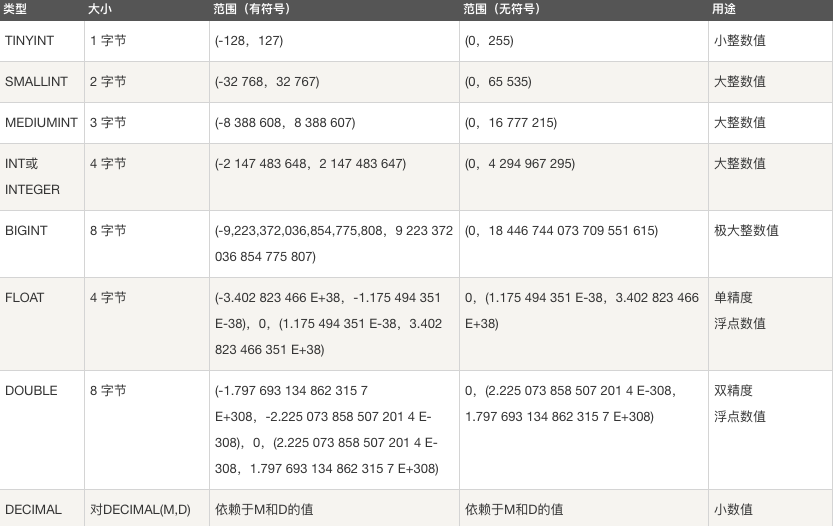
对于精度比较高的东西,比如money,用decimal类型提高精度减少误差。列的声明语法是DECIMAL(M,D)。
M是数字的最大位数(精度)。其范围为1~65,M 的默认值是10。
D是小数点右侧数字的数目(标度)。其范围是0~30,但不得超过M。
比如 DECIMAL(6,2)最多存6位数字,小数点后占2位,取值范围-9999.99到9999.99。
比特值类型指0,1值表达2种情况,如真,假
字符串类型:
- char和varchar类型
- binary和varbinary类型
- blob和text类型
- enum类型和set类型
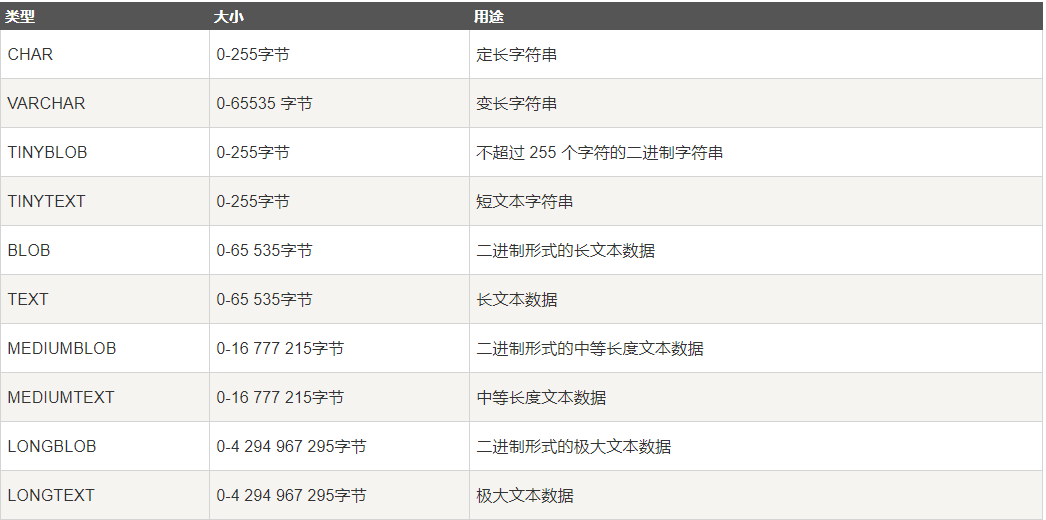
- char 和 varchar
char:定长,效率高,一般用于固定长度的表单提交数据存储,默认1字符
varchar:不定长,效率偏低
- text 和blob
text用来存储非二进制文本
blob用来存储二进制字节串
- enum 和 set
enum用来存储给出的一个值
set用来存储给出的值中一个或多个值
表的基本操作:
创建表(指定字符集)
create table 表名(
字段名 数据类型,
字段名 数据类型,
...
字段名 数据类型
);
- 如果你想设置数字为无符号则加上 unsigned
- 如果你不想字段为 NULL 可以设置字段的属性为 NOT NULL, 在操作数据库时如果输入该字段的数据为NULL ,就会报错。
- DEFAULT 表示设置一个字段的默认值
- AUTO_INCREMENT定义列为自增的属性,一般用于主键,数值会自动加1。
- PRIMARY KEY关键字用于定义列为主键。主键的值不能重复。
案例:创建班级表
create table class_1 (id int primary key auto_increment,name varchar(32) not null,age int not null,sex enum('w','m'),score float default 0.0);
案例:创建兴趣班表
create table interest (id int primary key auto_increment,name varchar(32) not null,hobby set('sing','dance','draw'),course char not null,price decimal(6,2),comment text);
查看数据表
show tables;
查看已有表的字符集
show create table 表名;
查看表结构
desc 表名;
删除表
drop table 表名;
数据基本操作
插入(insert)
insert into 表名 values(值1),(值2),...;
insert into 表名(字段1,...) values(值1),...;
案例:insert into class_1 values (2,'Baron',10,'m',91),(3,'Jame',9,'m',90);
查询(select)
select * from 表名 [where 条件];
select 字段1,字段名2 from 表名 [where 条件];
案例:select * from class_1;
案例:select name,age from class_1;
where子句
where子句在sql语句中扮演了重要角色,主要通过一定的运算条件进行数据的筛选
MySQL 主要有以下几种运算符:
算术运算符
比较运算符
逻辑运算符
位运算符
算数运算符

案例:select * from class_1 where age % 2 = 0;
比较运算符
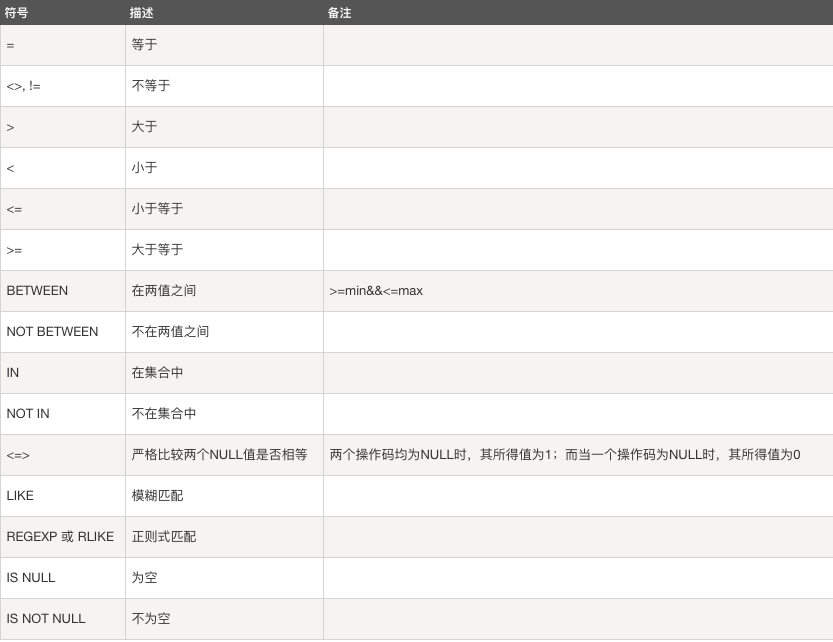
案例:
select * from class_1 where age > 8;
select * from class_1 where between 8 and 10;
select * from class_1 where age in (8,9);
逻辑运算符

案例:select * from class_1 where sex='m' and age>9;
位运算符

更新表记录(update)
update 表名 set 字段1=值1,字段2=值2,... where 条件;
案例:update class_1 set age=11 where name='Abby';
删除表记录(delete)
delete from 表名 where 条件;
注意:delete语句后如果不加where条件,所有记录全部清空
案例:delete from class_1 where name='Abby';
表字段的操作(alter)
语法 :alter table 表名 执行动作;
* 添加字段(add)
alter table 表名 add 字段名 数据类型;
alter table 表名 add 字段名 数据类型 first;
alter table 表名 add 字段名 数据类型 after 字段名; * 删除字段(drop) alter table 表名 drop 字段名; * 修改数据类型(modify) alter table 表名 modify 字段名 新数据类型; * 修改字段名(change) alter table 表名 change 旧字段名 新字段名 新数据类型; * 表重命名(rename) alter table 表名 rename 新表名;
案例:alter table interest add date Date after course;
|
表管理 |
代码 |
|
创建表 |
create table 表名( |
|
查看数据表 |
show tables; |
|
查看已有表的字符集 |
show create table 表名; |
|
查看表结构 |
desc 表名; |
|
插入(insert into) |
insert into 表名 values(值1,值2,...),(值1,值2,...); |
|
|
insert into 表名 (字段1,...) values(值1,...); |
|
查询(select) |
select 字段1,... from 表名 where 条件; |
|
|
select 字段,字段2,... from 表名;(千万别用*) |
|
更新表记录(update)修改 |
update set 字段1=值1,... where 条件; |
|
删除表记录(delete) |
delete from 表名 where 条件; |
|
删除表(drop) |
drop table 表名; |
|
表字段的操作(alter) |
|
|
添加字段(add) 默认末尾添加 |
alter table 表名 add 字段名 数据类型; |
|
第一处添加first |
alter table 表名 add 字段名 数据类型 first; |
|
在哪个字段名后面添加after |
alter table 表名 add 字段名 数据类型 after 字段名; |
|
删除字段(drop) |
alter table 表名 drop 字段名; |
|
修改数据类型(modify) |
alter table 表名 modify 字段名 新数据类型; |
|
修改字段名(change) |
alter table 表名 change 旧字段名 新字段名 新数据类型 (新旧字段名相同也可以修改数据类型) |
|
表重命名(rename) |
alter table 表名 rename 新表名; |
时间类型数据
时间和日期类型:
DATE,DATETIME和TIMESTAMP类型
TIME类型
年份类型YEAR
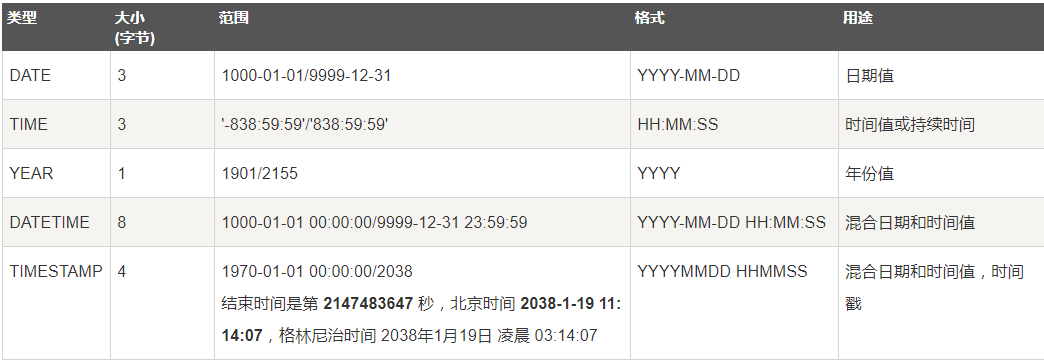
时间格式
date :"YYYY-MM-DD"
time :"HH:MM:SS"
datetime :"YYYY-MM-DD HH:MM:SS"
timestamp :"YYYY-MM-DD HH:MM:SS"
注意
1、datetime :不给值默认返回NULL值
2、timestamp :不给值默认返回系统当前时间
日期时间函数
- now() 返回服务器当前时间
- curdate() 返回当前日期
- curtime() 返回当前时间
- date(date) 返回指定时间的日期
- time(date) 返回指定时间的时间
时间操作
- 查找操作
select * from timelog where Date = "2018-07-02";
select * from timelog where Date>="2018-07-01" and Date<="2018-07-31";
-
日期时间运算
-
语法格式
select * from 表名 where 字段名 运算符 (时间-interval 时间间隔单位);
-
时间间隔单位: 1 day | 2 hour | 1 minute | 2 year | 3 month
-
案例:select * from timelog where shijian > (now()-interval 1 day);
高级查询语句
模糊查询和正则查询
LIKE用于在where子句中进行模糊查询,SQL LIKE 子句中使用百分号 %字符来表示任意字符。
使用 LIKE 子句从数据表中读取数据的通用语法:
select field1, field2,...fieldN
from table_name
where field1 LIKE condition1
案例:mysql> select * from class_1 where name like 'A%';
mysql中对正则表达式的支持有限,只支持部分正则元字符
select field1, field2,...fieldN
from table_name
where field1 REGEXP condition1
案例:select * from class_1 where name regexp 'B.+';
排序
ORDER BY 子句来设定你想按哪个字段哪种方式来进行排序,再返回搜索结果。
使用 order by 子句将查询数据排序后再返回数据:
select field1, field2,...fieldN from table_name1 where field1
order by field1 [ASC [DESC]]
默认情况ASC表示升序,DESC表示降序
select * from class_1 where sex='m' order by age;
分页
LIMIT 子句用于限制由 SELECT 语句返回的数据数量 或者 UPDATE,DELETE语句的操作数量
带有 LIMIT 子句的 SELECT 语句的基本语法如下:
select column1, column2, columnN
from table_name
where field
limit [num]
联合查询
UNION 操作符用于连接两个以上的 SELECT 语句的结果组合到一个结果集合中。多个 SELECT 语句会删除重复的数据。
UNION 操作符语法格式:
SELECT expression1, expression2, ... expression_n
FROM tables
[WHERE conditions]
UNION [ALL | DISTINCT]
SELECT expression1, expression2, ... expression_n
FROM tables
[WHERE conditions];
expression1, expression2, ... expression_n: 要检索的列。
tables: 要检索的数据表。
WHERE conditions: 可选, 检索条件。
DISTINCT: 可选,删除结果集中重复的数据。默认情况下 UNION 操作符已经删除了重复数据,所以 DISTINCT 修饰符对结果没啥影响。
ALL: 可选,返回所有结果集,包含重复数据。
要求查询的字段必须相同
案例:select * from class_1 where sex='m' UNION ALL select * from class_1 where age > 9;
多表查询
多个表数据可以联合查询,语法格式如下
select 字段1,字段2... from 表1,表2... [where 条件]
案例:
select class_1.name,class_1.age,class_1.sex,interest.hobby from class_1,interest where class_1.name = interest.name;
|
功能 |
代码 |
|
模糊查询 (like 'a%','_') |
select * from 表名 where 字段名 like 'a%'; 例句:select * from class_1 where name like 'A%';(查找class_1表中名字A开头的名字) 例句:select * from class_1 where name like '__';(一个'_'代表一个字符,查找class_1表中两个字符的名字) |
|
正则查询(regexp) |
例句:select * from class_1 where name regexp 'B.+';(regexp正则查询) |
|
排序 (升序order by) (降序order by desc) |
select * from 表名 where 条件 order by 字段名; 例句:select * from class_1 where sex='男' order by age;(查找class_1表中男性按年龄升序排序) 例句:select * from class_1 where sex='男' order by age desc;(查找class_1表中男性按年龄降序排序) |
|
分页(limit) |
select 字段名 from 表名 where 条件 order by 字段 limit offset,num; 条件:1.当前要看第多少页set @current=2(多少页) 2.每页显示多少条数据,@pageSize=2(页的条数) select id,name,age,email from users limit (@current-1)*@pageSize,@pageSize;等于第二页第二条 select id,name,age,email from users limit 2,2; 例句:select * from class_1 where sex='男' order by age desc limit 1; (查找class_1表中男性按年龄降序排列 **显示一行**) 例句:select * from class_1 where sex='男' order by age desc limit 1; (查找class_1表中男性按年龄降序排列 **显示两行**) |
|
联合查询 (union) (union all) |
例句:select * from student where sex='女' union select * from student where score >85; (默认是或的意思 查找女生或85分以上的学生,默认去掉重复的数据) 例句:select * from student where sex='女' union all select * from student where score >85; (查找女生和85分以上的学生,两次查找无关联,第二次会重新查找) |
|
多表查询 |
select 表名.字段1,表名.字段2,... from 表1,表2,... where 条件; select class_1.name,class_1.age,class_1.sex,interest.hobby from class_1,interest where class_1.name=interest.name; (查找class_1表中的姓名,年龄,性别,interest表中的爱好 姓名相同的数据) |
数据备份
1.备份命令格式
mysqldump -u用户名 -p 源库名 > ~/***.sql (要备份的库名 ***.sql 备份起的名 )
--all-databases 备份所有库
库名 备份单个库
-B 库1 库2 库3 备份多个库
库名 表1 表2 表3 备份指定库的多张表
2.恢复命令格式
mysql -uroot -p 目标库名 < ***.sql (目标库名是恢复到的库 ***.sql 备份的库 )
从所有库备份中恢复某一个库(--one-database)
mysql -uroot -p --one-database 目标库名 < all.sql
Python操作MySQL数据库
pymysql安装
sudo pip3 install pymysql
pymysql使用流程
- 建立数据库连接(db = pymysql.connect(...))
- 创建游标对象(c = db.cursor())
- 游标方法: c.execute("insert ....")
- 提交到数据库 : db.commit()
- 关闭游标对象 :c.close()
- 断开数据库连接 :db.close()
常用函数
db = pymysql.connect(参数列表)
host :主机地址,本地 localhost
port :端口号,默认3306
user :用户名
password :密码
database :库
charset :编码方式,推荐使用 utf8
数据库连接对象(db)的方法
db.commit() 提交到数据库执行
db.rollback() 回滚
cur = db.cursor() 返回游标对象,用于执行具体SQL命令
db.close() 关闭连接
游标对象(cur)的方法
cur.execute(sql命令,[列表]) 执行SQL命令
cur.close() 关闭游标对象
cur.fetchone() 获取查询结果集的第一条数据 (1,100001,"河北省")
cur.fetchmany(n) 获取n条 ((记录1),(记录2))
cur.fetchall() 获取所有记录

1 import pymysql 2 3 # 连接数据库 4 db = pymysql.connect(host='localhost', 5 port=3306, 6 user='root', 7 passwd='123456', 8 database='stu', 9 charset='utf8') 10 11 # 获取游标(用于进行数据操作的对象,承载操作结果) 12 cur = db.cursor() 13 14 # 执行sql语句 15 sql = "insert into student \ 16 (name,age,gender,score) values \ 17 ('Lily',14,'w',79.5);" 18 cur.execute(sql) 19 20 db.commit() # 将写操作提交到数据库 21 22 # 关闭数据库 23 cur.close() 24 db.close()

1 import pymysql 2 3 # 连接数据库 4 db = pymysql.connect(host='localhost', 5 port=3306, 6 user='root', 7 passwd='123456', 8 database='stu', 9 charset='utf8') 10 11 # 获取游标(用于进行数据操作的对象,承载操作结果) 12 cur = db.cursor() 13 14 # 存储文件 15 # with open('boy.jpg','rb') as fd: 16 # data = fd.read() 17 # 18 # try: 19 # sql="insert into Image values (1,'boy.jpg',%s)" 20 # cur.execute(sql,[data]) 21 # db.commit() 22 # except Exception as e: 23 # print(e) 24 # db.rollback() 25 26 # 获取图片 27 sql = "select * from Image \ 28 where filename='boy.jpg'" 29 cur.execute(sql) 30 31 # (1,name,xxxxx) 32 img = cur.fetchone() 33 with open(img[1],'wb') as f: 34 f.write(img[2]) 35 36 # 关闭数据库 37 cur.close() 38 db.close()

1 """ 2 select语句 3 """ 4 5 import pymysql 6 7 # 连接数据库 8 db = pymysql.connect(host='localhost', 9 port=3306, 10 user='root', 11 passwd='123456', 12 database='stu', 13 charset='utf8') 14 15 # 获取游标(用于进行数据操作的对象,承载操作结果) 16 cur = db.cursor() 17 18 # 执行sql语句 19 sql = "select * from student where gender='m'" 20 cur.execute(sql) #执行查询后cur便会拥有查询结果 21 22 # 获取一个查询结果 23 one_row = cur.fetchone() 24 print(one_row) 25 26 # 获取多个查询结果 27 many_row = cur.fetchmany(2) 28 print(many_row) 29 30 # 获取全部查询结果 31 all_row = cur.fetchall() 32 print(all_row) 33 34 # 关闭数据库 35 cur.close() 36 db.close()

1 """ 2 增删改为写操作 3 """ 4 5 import pymysql 6 7 # 连接数据库 8 db = pymysql.connect(host='localhost', 9 port=3306, 10 user='root', 11 passwd='123456', 12 database='stu', 13 charset='utf8') 14 15 # 获取游标(用于进行数据操作的对象,承载操作结果) 16 cur = db.cursor() 17 18 # 执行sql语句 19 try: 20 # 插入数据 21 # name = input("name:") 22 # age = int(input('age:')) 23 # gender = input('gender:') 24 # score = float(input('score:')) 25 26 # sql = "insert into student (name,age,gender,score) \ 27 # values ('%s',%d,'%s',%f)"%(name,age,gender,score) 28 29 # sql = "insert into student (name,age,gender,score) \ 30 # values (%s,%s,%s,%s)" 31 32 # sql = "insert into interest values \ 33 # (3,'Joy','draw','B',5488.0,'画的鸡蛋还行')" 34 # cur.execute(sql,[name,age,gender,score]) 35 36 # 修改操作 37 # sql = "update student set age=22 \ 38 # where name = 'Lily'" 39 # cur.execute(sql) 40 41 # 删除操作 42 sql = "delete from student where score<60" 43 cur.execute(sql) 44 45 db.commit() # 可以执行多个sql语句一同提交 46 except Exception as e: 47 db.rollback() # 退回到commit之前的状态 48 print(e) 49 50 # 关闭数据库 51 cur.close() 52 db.close()



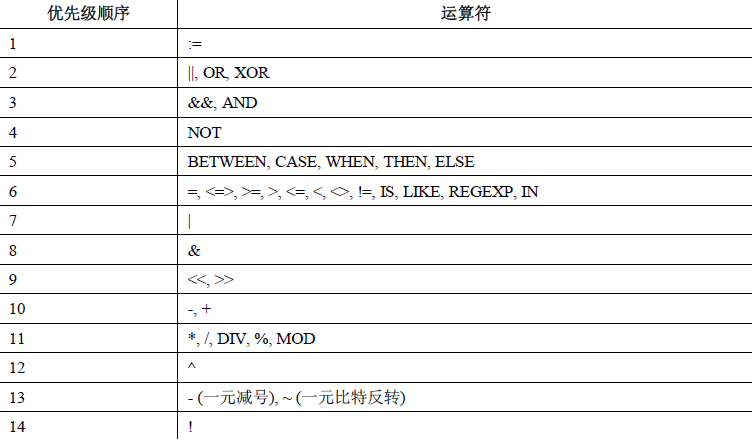


 浙公网安备 33010602011771号
浙公网安备 33010602011771号